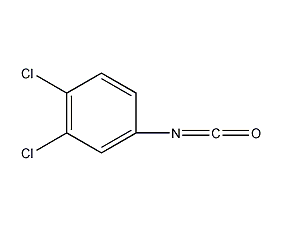
Structural formula
| Business number | 02LZ |
|---|---|
| Molecular formula | C7H3Cl2NO |
| Molecular weight | 188 |
| label |
3,4-Dichlorophenyl isocyanate, Isocyanic Acid 3,4-Dichlorophenyl Ester |
Numbering system
CAS number:102-36-3
MDL number:MFCD00002017
EINECS number:203-026-2
RTECS number:NQ8760000
BRN number:608325
PubChem number:24854744
Physical property data
1. Properties: white to light brown solid.
2. Density (g/mL, 25℃): Undetermined
3. Relative vapor density (g/mL, air=1): Undetermined
4. Melting point (ºC): 42~44
5. Boiling point (ºC, 2.34kpa): 118~120
6. Boiling point (ºC, 4kPa): 133
7. Refractive index: Undetermined
8. Flash point (ºC): >110
9. Specific rotation (º): Undetermined
7. p>
10. Autoignition point or ignition temperature (ºC): Undetermined
11. Vapor pressure (mmHg, 20ºC): 0.2
12. Saturated vapor pressure ( kPa, ºC): Undetermined
13. Heat of combustion (KJ/mol): Undetermined
14. Critical temperature (ºC): Undetermined
15. Critical pressure (KPa): Undetermined
16. Log value of oil-water (octanol/water) distribution coefficient: Undetermined
17. Explosion upper limit (%, V/ V): Undetermined
18. Lower explosion limit (%, V/V): Undetermined
19. Solubility: Soluble in organic solvents such as toluene and chlorobenzene.
Toxicological data
Acute toxicity: Rat oral LD50: 91mg/kg; Rat inhalation LC50: 2700mg/m3/4H; Rat skin contact LD: >5mg/kg; Rat peritoneal cavity LDLo: 100mg/kg; Mouse inhalation LC50: 140mg/m3/2H;
Ecological data
This substance may be harmful to the environment and it is recommended not to let it enter the environment.
Molecular structure data
1. Molar refractive index: 45.36
2. Molar volume (cm3/mol): 137.2
3. Isotonic specific volume (90.2K ): 352.9
4. Surface tension (dyne/cm): 43.7
5. Dielectric constant:
6. Dipole moment (10-24cm3):
7. Polarizability: 17.98
Compute chemical data
1. Reference value for hydrophobic parameter calculation (XlogP): None
2. Number of hydrogen bond donors: 0
3. Number of hydrogen bond acceptors: 2
4. Number of rotatable chemical bonds: 1
5. InterconversionNumber of conformers: None
6. Topological molecule polar surface area 29.4
7. Number of heavy atoms: 11
8. Surface charge: 0
p>
9. Complexity: 179
10. Number of isotope atoms: 0
11. Determine the number of atomic stereocenters: 0
12 .The number of uncertain atomic stereocenters: 0
13. The number of determined chemical bond stereocenters: 0
14. The uncertain number of chemical bond stereocenters: 0
15. Number of covalent bond units: 1
Properties and stability
Avoid contact with strong oxidants, strong bases, alcohols, amines, and water.
Storage method
Store in a cool, dry, well-ventilated warehouse. Keep away from fire and heat sources. Protect from direct sunlight. The packaging is sealed. They should be stored separately from oxidants, alkalis, alcohols, amines, food chemicals, etc., and avoid mixed storage. Equipped with the appropriate variety and quantity of fire equipment. Suitable materials should be available in the storage area to contain spills.
Synthesis method
The preparation method is to add toluene as the solvent in the reaction kettle, pass in a certain amount of phosgene under cooling, then dropwise add the toluene solution of 3,4-dichloroaniline, and continuously stir for a certain period of time, and control the reaction temperature at 0~3℃, then move to the hot reaction pot and continue to pass phosgene and heat it to a certain temperature. At this time, a large amount of hydrogen chloride and phosgene escape, which is absorbed by toluene. The tail gas enters the tail gas treatment device and becomes transparent through the solution. liquid, use nitrogen to drive away the remaining phosgene and hydrogen chloride at the end of the reaction, then move it to the distillation kettle, and evaporate the solvent to obtain the finished product.
Purpose
Used as pesticide and pharmaceutical intermediates.
Intermediates for the synthesis of herbicides linuron, benzofuron and diuron.

 微信扫一扫打赏
微信扫一扫打赏

